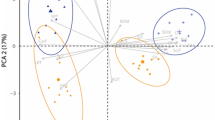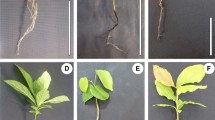Summary
The growth responses of seedlings of Amphipterygium adstringens, Caesalpinia eriostachys, and C. platyloba, species associated with undisturbed parts of the tropical deciduous forest in México, and Apoplanesia paniculata and Heliocarpus pallidus, two gap-requiring pioneer species, were determined under contrasting light conditions in a growth chamber experiment. The high (400 μmol m−2 s−1) and low (80 μmol m−2 s−1) light treatments correspond to the light available in a medium size gap and underneath the vegetation canopy in the deciduous forest during the rainy season, respectively. Following four destructive harvests the biomass production, relative growth rate, root/shoot ratio, specific leaf area, net assimilation rate, leaf area ratio and light dependency were determined for all species. In the high light treatment all species achieved higher relative growth rates and net assimilation rates than when growing at low light intensity. However, the two pioneer species showed the highest light dependency and were the species more affected by the low light treatment in biomass production. The two Caesalpinia species showed similar growth responses, but C. platyloba was the most shade tolerant species. Plastic adjustments in terms of the specific leaf area were more evident in the two pioneer species.
Similar content being viewed by others
References
Augspurger CK (1984) Light requirements of neotropical tree seedlings: a comparative study of growth and survival. J Ecol 72: 777–795
Barton AM, Fetcher N, Redhead A (1989) The relationship between treefall gap size and light flux in a Neotropical rain forest in Costa Rica. J Trop Ecol 5: 437–439
Bazzaz FA, Pickett STA (1980) Physiological ecology of tropical succession: a comparative review. Annu Rev Ecol Syst 11: 287–310
Brokaw NVL (1985) Gap phase regeneration in a tropical forest. Ecology 66: 682–687
Bullock SH (1986) Climate of Chamela, Jalisco, and trends in the south coastal region of Mexico. Arch Meteorol Geophys Bioclimatol 36: 297–316
Bullock SH, Solis-Magallanes A (1990) Phenology of canopy trees of a tropical deciduous forest in Mexico. Biotropica 22: 22–35
Causton DR, Venus JC (1981) The biometry of plant growth. Edward Arnold, London
Chazdon RL (1986) Light variation and carbon gain in rainforest understory palms. J Ecol 74: 995–1012
Chazdon RL (1988) Sunflecks and their importance to forest understory plants. Adv Ecol Res 18: 1–63
Chazdon RL, Fetcher N (1984) Photosynthetic light environments in a lowland tropical rainforest in Costa Rica. J Ecol 71: 553–564
Chazdon RL, Field CB (1987) Determinants of photosynthetic capacity in six rainforest Piper species. Oecologia 73: 222–230
Chazdon RL, Pearcy RW (1986a) Photosynthetic responses to light variation in rainforest species. I. Induction under constant and fluctuating light conditions. Oecologia (Berlin) 69: 517–523
Chazdon RL, Pearcy RW (1986b) Photosynthetic responses to light variation in rainforest species. II. Carbon gain and photosynthetic efficiency during sunflecks. Oecologia 69: 524–531
Denslow JS (1980) Gap partitioning among tropical rainforest trees. Biotropica 12: 47–55
Denslow JS (1987) Tropical rainforest gaps and tree species diversity. Annu Rev Ecol Syst 18: 431–451
Evans GC (1972) The quantitative analysis of plant growth. Blackwells, Oxford
Hewitt EJ (1966) Sand and water culture methods used to study plant nutrition, 2nd edn. Technical Communications No. 22, Commonwealth Agricultural Bureaux, Farnham Royal, England
Hunt R (1982) Plant growth curves: the functional approach to plant growth analysis. Edward Arnold, London
King DA (1991) Correlations between biomass allocation, relative growth rate and light environment in tropical forest saplings. Func Ecol 5: 485–492
Lang GE, Knight DH (1983) Tree growth, mortality, recruitment, and canopy gap formation during a 10-year period in a tropical moist forest. Ecology 64: 1075–1080
Lott E (1985) Listado florístico de la estación de biología Chamela, Mexico. Instituto de Biología, Universidad Nacional Autónoma de México
Lott E, Bullock SH, Solis-Magallanes JA (1987) Floristic diversity and structure of upland and arroyo forests in coastal Jalisco. Biotropica 19: 228–235
Martinez-Ramos M, Alvarez-Buylla E (1986) Gap dynamics, seed dispersal and tree recruitment: the case of Cecropia obtusifolia at Los Tuxtlas In: Estrada A, Fleming TH (eds) Frugivores and seed dispersal. Junk, Dordrecht, pp 323–346
Martinez-Ramos M, Alvarez-Buylla E, Sarukhán J, Piñero D (1988) Tree fall age determination and gap dynamics in a tropical forest. J Ecol 76: 700–715
Martinez-Yrizar A, Sarukhán J, Perez-Jimenez A, Rincón E, Maass JM, Solis-Magallanes A, Cervantes L (1992) Above-ground living phytomass of a tropical deciduous forest in the coast of Jalisco, México. J Trop Ecol 8: 87–96
Molofsky J, Augspurger CK (1992) The effect of leaf litter on early seedling establishment in a tropical forst. Ecology 73: 68–77
Murphy PG, Lugo AE (1986) Ecology of tropical dry forest. Ann Rev Ecol Sys 17: 67–88
Orozco-Segovia A, Vázquez-Yanes C (1989) Light effects on seed germination in Piper L. Oecol Plant 10: 123–146
Pearcy RW (1983) The light environment and growth of C3 and C4 tree species in the understorey of a Hawaiian forest. Oecologia 58: 19–25
Sanchez-Coronado M, Rincón E, Vázquez-Yanes C (1990) Growth responses of three Piper species growing under contrasting light conditions. Can J Bot 68: 1182–1186
Turner IM (1990) Tree seedling growth and survival in a Malaysian rain forest. Biotropica 22: 146–156
Vázquez-Yanes C, Orozco-Segovia A (1982) Germination of seeds of a tropical rain forest shrub, Piper hispidum Sw (Piperaceae) under different light qualities. Phyton 42: 143–149
Vázquez-Yanes C, Orozco-Segovia A (1984) Ecophysiology of seed germination in the tropical humid forests In: Medina E, Mooney HA, Vazquez-Yanes C (eds) Physiological ecology of plants of the wet tropics. Junk, The Hague, pp 37–50
Vázquez-Yanes C, Orozco-Segovia A, Rincón E, Sánchez-Coronado ME, Huante P, Toledo J and Barradas VL (1990) Light beneath the litter in a tropical forest: effect on seed germination. Ecology 71: 1952–1958
Walters MB, Field CB (1987) Photosynthetic light acclimation in two rainforest Piper species with different ecological amplitudes. Oecologia 72: 449–456
Zar JH (1974) Biostatistical analysis. Prentice Hall, Englewood Cliffs, USA
Author information
Authors and Affiliations
Rights and permissions
About this article
Cite this article
Rincón, E., Huante, P. Growth responses of tropical deciduous tree seedlings to contrasting light conditions. Trees 7, 202–207 (1993). https://doi.org/10.1007/BF00202074
Received:
Issue Date:
DOI: https://doi.org/10.1007/BF00202074




